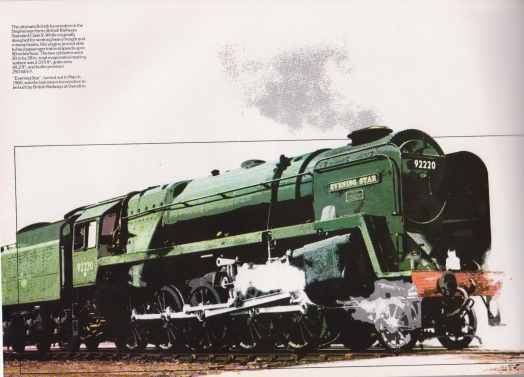Evening Star
Resource Type: Image | Posted on 5th December 2011 by Liam Physick
This illustration from The Rainhill Locomotive Trials shows the appropriately-named BR No. 92220 Evening Star, the last steam locomotive to be built by British Railways. As such it was, uniquely, earmarked for preservation from the outset and was also the 999th locomotive in the BR Standard range. It belongs to Standard Class 9F, a class of 251 2-10-0 locomotives designed by R A Riddles and intended primarily to pull fast and heavy goods trains over long distances, but equally suitable for express passenger trains. They were built between 1954 and 1960: thus the first of them came out just one year before BR decided to abolish steam traction. Intended to last 20 years, the Modernisation Plan ensured that the 9Fs would be in service for less than half that time. 198 of the locomotives were built at Crewe, the remaining 53 at Swindon, like the Evening Star. The 9Fs (9 is the highest possible power rating, and “F” stands for freight) were numbered 92000-92250: curiously, the Evening Star, the last to be built, was not the last numerically, as BR had already given higher numbers to some of its classmates. It was named after the Evening Star newspaper as a result of a competition run in 1959-60 by the BR Western Region staff magazine: the name Evening Star had previously been given to two Great Western Railway (the predecessor of the Western Region) locomotives, and was felt to be apt for BR’s last steam locomotive. The Evening Star was named at a special ceremony at the ex-GWR works at Swindon, where it had been built the previous month, on 18th March 1960, and has a commemorative plaque fixed below its nameplate on its smoke deflectors. R F Hanks gave a speech in which he paid tribute to the steam locomotive, saying, “I am sure that no other product of man’s mind has ever excercised such a compelling hold upon the public’s imagination as the steam locomotive. No other machine in its day has been a more faithful friend to mankind nor has contributed more to the growth of industry in the land of its birth and indeed through the whole world . . . Those who have lived in the steam age of railways will carry the most nostalgic memories to the end.” Then Keith Grand, a member of the British Transport Commission, unveiled the locomotive, revealing its name. It was the only 9F locomotive to be named by BR, though others in the Class have been named in preservation. It was also painted in specially-commissioned Brunswick green livery, rather than BR black like its classmates. The Evening Star worked on BR’s Western Region and was originally based at Cardiff Canton depot, and was then used to haul the Red Dragon express passenger service to London, and once reached 90 miles per hour pulling this train. However, as dieselisation advanced, it and other 9Fs were relegated to service on the Somerset and Dorset Joint Railway: on 8th September 1962, the Evening Star pulled the last-ever Pines Express (a passenger train between Manchester and Bournemouth) on the S&DJR, shortly before the line closed (the service was then diverted to former GWR routes). But it was only in service for five years, until March 1965 (one year after withdrawals of Standard Class 9Fs began), following an accident with a tank locomotive, and then, after being overhauled, became part of the National Collection. It has been steamed in preservation several times, but is now a static exhibit at the National Railway Museum. Following a brief display at the Shildon Locomotion Museum in County Durham, the Evening Star returned to Swindon Works on 3rd September 2008. It was exhibited for two years at STEAM - Museum of the Great Western Railway at Swindon, to mark the GWR’s 175th anniversary, with GWR No. 6000 King George V (part of the GWR’s 6000 Class) taking its place at the NRM. Most recently, the Evening Star was at the centre of a bizarre mystery: in late 2009, it came to be rumoured that after withdrawal it swapped identities and boilers with one of its classmates. Furthermore, the artist David Shepherd, owner of No. 92203 Black Prince, announced that when work was being carried out on his locomotive, some of the Evening Star’s Brunswick green paint was discovered under the Black Prince’s black livery, and that some parts were stamped 92220. The name “The Evening Star” was also given in 2010 to a Class 90 electric locomotive. Eight other 9Fs have been preserved along with the Evening Star - the Black Prince was bought directly from BR by David Shepherd, while the rest were rescued from Barry scrapyard
Categorised under: Landmarks, Landscapes & Locomotives

Comments
I have attempted to officially find out about the actual true colour green, you mention brunswick green some say that never became a recognised colour, could you confirm the correct green used please. regards Russell
I know this is very late and you may well have found the answer. The correct colour green for Evening Star was BR Locomotive Green. Brunswick Green was a ‘nickname’ never used officially. I actually bought 5 litres out of the last batch of BR Loco Green Spec 58 Item 12, made specifically for the repaint of Evening Star, at Brighton Works, before she went up to the NRM. The paint is for use as the final coat on my 5” gauge model of Evening Star, being built to works detail drawings, of which I have over 500.